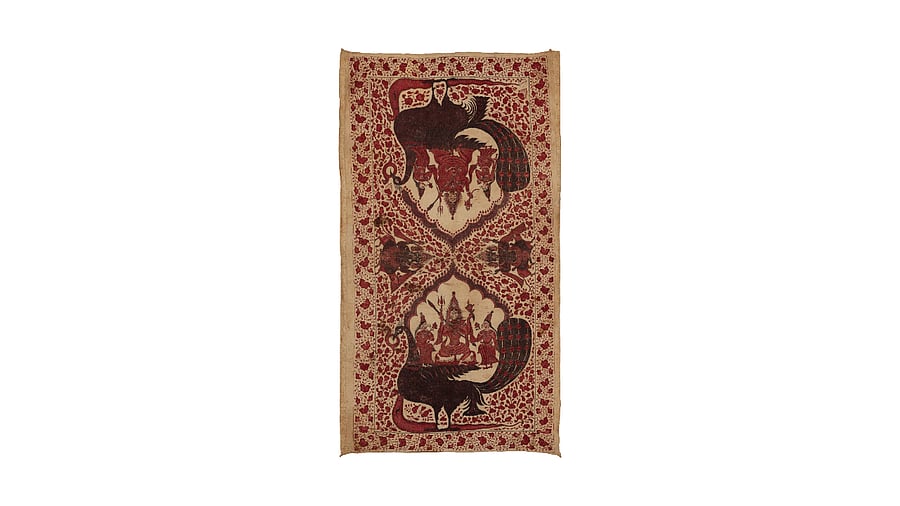
Temple banner, late 19th-early 20th century, cotton, natural dyes, South India or Sri Lanka.
Credit: MAP
It’s a well-known fact that India has long been a global textile powerhouse, with a rich cultural and historical legacy spanning thousands of years. Renowned for its intricate weaving, dyeing, and embroidery techniques, Indian textiles have been prized worldwide.
Fabrics such as muslin, khadi, and silk were integral to trade, with India exporting them to the Middle East, Europe, and beyond. Also integral was the art of block printing, Kalamkari, and ikat weaving, which remain influential to this day.
While we often read about India’s textile trade links with the Middle East and Europe, we tend to sideline our beloved neighbour — Sri Lanka. India and Sri Lanka have shared rich trade links for centuries, dating back to ancient times. The textile trade, particularly in cotton and silk, flourished between the two nations as early as the third century BCE. India’s expertise in weaving and dyeing has had a significant impact on Sri Lankan fabric traditions. This link is being explored at an ongoing exhibition, ‘Chay Reds, Ferrous Blacks’, at the Museum of Art and Photography (MAP).
The exhibition does justice to its name. On display here, you will find beautifully intricate pieces of fabric dating back to the 18th-19th century. They possess the deep red colour of the chay root, accompanied by detailing the colour black lends, making for some striking pieces of art.
“In Sri Lanka, these fabrics were more than mere decoration. They were prized possessions, symbols of prestige, and an integral part of their daily lives,” shares textile designer and researcher Yash Sanhotra, who has curated the show, as he talks about the ‘Somana Tuppotiya’. The Somana Tuppotiya is a traditional Sri Lankan garment worn during ceremonial occasions.
Crafted from intricate fabrics like silk, it is often adorned with gold or silver embellishments. The long rectangular piece of cloth was draped around the waist, with pleats in the front, and typically fastened with a decorative belt or sash — sound familiar? The piece of clothing is reminiscent of the Indian Antariya and Kayabandh. The fabrics have varied patterns — from checkered red and cream prints to beautifully uniform florals.
Sacred motifs
The patterns and motifs seen on these textile materials are reflective of the culture and natural resources in Sri Lanka, says Yash. Some of the common motifs include peacocks, elephants, horses and swans. “Peacock or Mayura is considered to be a protective creature in Buddhist, Hindu, and ancient Vedda traditions for the protection they provide against venomous creatures such as snakes and centipedes.
It is also the mount of Lord Skanda Kumara, a significant syncretic deity in Sri Lanka. Hamsa (swan) is often used as a decorative and spiritual element in South Asian art. It is significant to Buddhism as it symbolises wisdom. According to Hindu mythology, it is the mount of Hindu deities Brahma, Saraswati as well as Vishwakarma. It is known to have the mythical ability to extract milk from a mixture of milk and water, a metaphor for the differentiation of good from evil,” he tells DHoS.
Another common motif seen across textiles exported from India to Sri Lanka is the Gandaberunda. Karnataka’s state emblem, the Gandaberunda is a mythical two-headed bird that symbolises strength, protection, and divine power in Hindu mythology. This powerful bird, often depicted with multiple wings, is a symbol of resilience, overcoming challenges, and regeneration. In Karnataka’s cultural history, the Gandeberunda is closely associated with the region’s royal heritage, particularly the Vijayanagara Empire, where it was used as a royal insignia.
Kindura and Makara are other prominent mythological motifs. “Kindura, also known as Kinnara, is a mythical creature significant to both Buddhism and Hinduism. These protective creatures can be described as part human, part bird often depicted holding a musical instrument which signifies their strong association with music.
This mythical creature is said to have immense divine power. Makara is the Sinhalese term for dragons, and this motif is often displayed in the art and architecture of Hindu temples and Buddhist Stupas. It is also an emblem of the Karava clan, an ethnic group in Sri Lanka,” adds Yash.
An ode to Indian textiles can also be found in the various temples of Sri Lanka. One such example is the murals at the Sri Subodharma Raja Maha Vihara, a Buddhist temple in Dehiwala, in the western province of Sri Lanka. The murals adorning the interior walls of the temple depict the life of Gautama Buddha and feature 19th-century patterned textiles from India.
Need for conservation
The textiles on display belong to an extensive collection of trade textiles at MAP. It took Yash and his team approximately five months to put together the exhibition.
Given the fragile nature of the fabrics, the exhibition will only be on display for a mere three months. “This is to limit the exposure of objects to environmental factors that affect the condition of the textiles over a longer period,” adds Yash.
To maintain the vibrance and integrity of the fabrics, the team at MAP is constantly monitoring factors such as lighting, temperature and humidity.
Shedding light on the need to conserve and document this part of history, Yash says, “It is important to highlight lesser-known maritime trade histories to pave a path for further scholarship by exploring visual and cultural attributes in the landscape of Indian textiles and textile traditions found in Sri Lanka between the 18th and 19th centuries. We’ve attempted to do this through various viewfinders — costume, lifestyle, commerce and spirituality.”
The exhibition is on until March 2025, at the Museum of Art and Photography, Kasturba Road, Bengaluru.